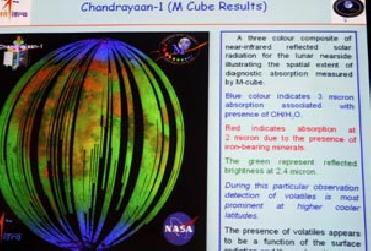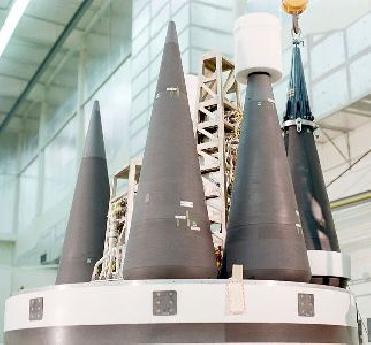
File photo of an image taken by Chandrayaan-1, relating to the presence of water on Moon. PTI Photo
WASHINGTON (PTI): Scientists have detected more than 40 ice-filled craters in the moon's North Pole using data from a NASA radar that flew aboard India's Chandrayaan-I.
NASA's Mini-SAR instrument, lightweight, synthetic aperture radar, found more than 40 small craters with water ice. The craters range in size from 2 to 15 km in diameter.
The finding would give future missions a new target to further explore and exploit, a NASA statement said, adding it is estimated that there could be at least 600 million metric tons of water ice in the craters.
"The emerging picture from the multiple measurements and resulting data of the instruments on lunar missions indicates that water creation, migration, deposition and retention are occurring on the moon," Paul Spudis, principal investigator of the Mini-SAR experiment at the Lunar and Planetary Institute, said on Monday.
The new discoveries show that the moon is an even more interesting and attractive scientific, exploration and operational destination than previously thought, he said.
Aboard Chandrayaan-I, the Mini-SAR mapped the moon's permanently-shadowed polar craters that are not visible from the earth. The radar uses the polarisation properties of reflected radio waves to characterise surface properties.
According to the findings which are being published in the latest issue of the Geophysical Research Letters journal, results from the mapping showed deposits having radar characteristics similar to ice.
"After analysing the data, our science team determined a strong indication of water ice, a finding which will give future missions a new target to further explore and exploit," Jason Crusan, program executive for the Mini-RF Program for NASA's Space Operations Mission Directorate, said.
The space agency said these results are consistent with recent findings of other NASA instruments and add to growing scientific understanding of the multiple forms of water found on the moon.
The agency's Moon Mineralogy Mapper discovered water molecules in the moon's Polar Regions, while water vapour was detected by NASA's Lunar Crater Observation and Sensing Satellite.
Mini-SAR and Moon Mineralogy Mapper are two of 11 instruments on India's first unmanned mission to the moon -- Chandrayaan-I.
 Next Article
Next Article











The Indian Air Force, in its flight trials evaluation report submitted before the Defence Ministry l..
view articleAn insight into the Medium Multi-Role Combat Aircraft competition...
view articleSky enthusiasts can now spot the International Space Station (ISS) commanded by Indian-American astr..
view article